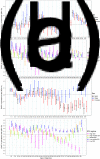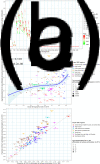Global, regional and national burden of anxiety disorders from 1990 to 2019: results from the Global Burden of Disease Study 2019
- PMID: 33955350
- PMCID: PMC8157816
- DOI: 10.1017/S2045796021000275
Global, regional and national burden of anxiety disorders from 1990 to 2019: results from the Global Burden of Disease Study 2019
Abstract
Aims: Anxiety disorders are widespread across the world. A systematic understanding of the disease burden, temporal trend and risk factors of anxiety disorders provides the essential foundation for targeted public policies on mental health at the national, regional, and global levels.
Methods: The estimation of anxiety disorders in the Global Burden of Disease Study 2019 using systematic review was conducted to describe incidence, prevalence and disability-adjusted life years (DALYs) in 204 countries and regions from 1990 to 2019. We calculated the estimated annual percentage change (EAPC) to quantify the temporal trends in anxiety disorders burden by sex, region and age over the past 30 years and analysed the impact of epidemiological and demographic changes on anxiety disorders.
Results: Globally, 45.82 [95% uncertainty interval (UI): 37.14, 55.62] million incident cases of anxiety disorders, 301.39 million (95% UI: 252.63, 356.00) prevalent cases and 28.68 (95% UI: 19.86, 39.32) million DALYs were estimated in 2019. Although the overall age-standardised burden rate of anxiety disorders remained stable over the past three decades, the latest absolute number of anxiety disorders increased by 50% from 1990. We observed huge disparities in both age-standardised burden rate and changing trend of anxiety disorders in sex, country and age. In 2019, 7.07% of the global DALYs due to anxiety disorders were attributable to bullying victimisation, mainly among the population aged 5-39 years, and the proportion increased in almost all countries and territories compared with 1990.
Conclusion: Anxiety disorder is still the most common mental illness in the world and has a striking impact on the global burden of disease. Controlling potential risk factors, such as bullying, establishing effective mental health knowledge dissemination and diversifying intervention strategies adapted to specific characteristics will reduce the burden of anxiety disorders.
Keywords: Anxiety disorders; bullying victimisation; global burden; systematic analysis.
Conflict of interest statement
The authors declare no potential conflicts of interest.
Figures





Similar articles
-
Global trends and regional differences in the burden of anxiety disorders and major depressive disorder attributed to bullying victimisation in 204 countries and territories, 1999-2019: an analysis of the Global Burden of Disease Study.Epidemiol Psychiatr Sci. 2022 Nov 28;31:e85. doi: 10.1017/S2045796022000683. Epidemiol Psychiatr Sci. 2022. PMID: 36440549 Free PMC article.
-
The global, regional, and national burden of oesophageal cancer and its attributable risk factors in 195 countries and territories, 1990-2017: a systematic analysis for the Global Burden of Disease Study 2017.Lancet Gastroenterol Hepatol. 2020 Jun;5(6):582-597. doi: 10.1016/S2468-1253(20)30007-8. Epub 2020 Apr 1. Lancet Gastroenterol Hepatol. 2020. PMID: 32246941 Free PMC article.
-
Trends in the incidence and DALYs of anxiety disorders at the global, regional, and national levels: Estimates from the Global Burden of Disease Study 2019.J Affect Disord. 2022 Jan 15;297:83-93. doi: 10.1016/j.jad.2021.10.022. Epub 2021 Oct 20. J Affect Disord. 2022. PMID: 34678404
-
Global prevalence and burden of depressive and anxiety disorders in 204 countries and territories in 2020 due to the COVID-19 pandemic.Lancet. 2021 Nov 6;398(10312):1700-1712. doi: 10.1016/S0140-6736(21)02143-7. Epub 2021 Oct 8. Lancet. 2021. PMID: 34634250 Free PMC article.
-
The contribution of bullying victimisation to the burden of anxiety and depressive disorders in Australia.Epidemiol Psychiatr Sci. 2019 Sep 19;29:e54. doi: 10.1017/S2045796019000489. Epidemiol Psychiatr Sci. 2019. PMID: 31533868 Free PMC article.
Cited by
-
Personalized online intervention based on a risk algorithm for the universal prevention of anxiety disorders: Design and development of the prevANS intervention.Digit Health. 2024 Oct 25;10:20552076241292418. doi: 10.1177/20552076241292418. eCollection 2024 Jan-Dec. Digit Health. 2024. PMID: 39493626 Free PMC article.
-
Effect of intensive weekend mindfulness-based intervention on BDNF, mitochondria function, and anxiety. A randomized, crossover clinical trial.Compr Psychoneuroendocrinol. 2022 Apr 29;11:100137. doi: 10.1016/j.cpnec.2022.100137. eCollection 2022 Aug. Compr Psychoneuroendocrinol. 2022. PMID: 35757176 Free PMC article.
-
Thirty-year trends of anxiety disorders among adolescents based on the 2019 Global Burden of Disease Study.Gen Psychiatr. 2024 Apr 3;37(2):e101288. doi: 10.1136/gpsych-2023-101288. eCollection 2024. Gen Psychiatr. 2024. PMID: 38595856 Free PMC article.
-
Determinants of adolescents' depression, anxiety, and somatic symptoms in Northwest Ethiopia: A non-recursive structural equation modeling.PLoS One. 2024 Apr 10;19(4):e0281571. doi: 10.1371/journal.pone.0281571. eCollection 2024. PLoS One. 2024. PMID: 38598540 Free PMC article.
-
Multilevel perspectives on the implementation of the collaborative care model for depression and anxiety in primary care.BMC Psychiatry. 2024 Jul 22;24(1):519. doi: 10.1186/s12888-024-05930-w. BMC Psychiatry. 2024. PMID: 39039458 Free PMC article.
References
-
- Baxter AJ, Vos T, Scott KM, Ferrari AJ and Whiteford HA (2014) The global burden of anxiety disorders in 2010. Psychological Medicine 44, 2363–2374. - PubMed
-
- Beesdo-Baum K and Knappe S (2012) Developmental epidemiology of anxiety disorders. Child and Adolescent Psychiatric Clinics of North America 21, 457–478. - PubMed
Publication types
MeSH terms
LinkOut - more resources
Full Text Sources
Other Literature Sources
Medical
Miscellaneous

